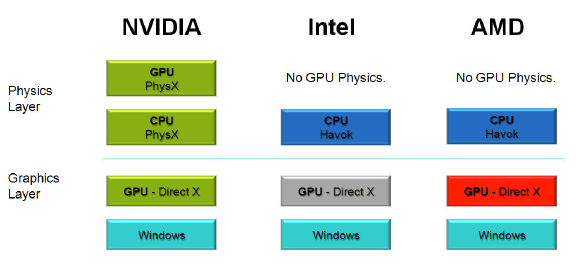The Two Physics Engines
There are two competing physics engines today - PhysX and Havok, controlled by NVIDIA and Intel respectively. ATI/AMD does not have a physics engine of their own but they are working with Intel on delivering GPU acceleration for Havok. As it stands, NVIDIA is the only company to offer GPU acceleration for physics. Havok currently runs only on the CPU.

Is Physics Better On The CPU Or The GPU?
For all the strides engineers have made with the CPU, its best example is still limited to four processing cores. This limits the number of threads it can execute concurrently. The best NVIDIA GPU, on the other hand, has 240 stream processors, allowing it to easily outpace the CPU even though GPUs usually run at much lower clock speeds than CPUs.
Core 2 Quad |
GeForce GTX |
|
Cores |
4 |
240 |
GFLOPS |
96 |
930 |
Fluids |
1x |
15x |
Soft Bodies |
1x |
15x |
Cloth |
1x |
15x |
The number of processing cores or stream processors is important because it can limit the complexity of the game physics. Take a look at the comparison on the right.
Because of the large number of stream processors, the NVIDIA GeForce GTX 280 can handle about 15x more physics calculations than an Intel Core 2 Quad Q9650. Even if we assume that just 1/5 of the GPU's stream processors are used to process game physics, the GeForce GTX 280 would still be able to deliver 3x more physics calculations than the Core 2 Quad processor.
A game developer supporting Havok would have to cut down the amount of game physics to ensure that their game would run well with a far less expensive processor, like a Core 2 Duo E8500 for example.
A game developer supporting PhysX, on the other hand, would have greater flexibility in introducing more game physics. The average NVIDIA graphics card has 128 stream processors, which should have no problem handling 3x-5x more physics calculations than the average dual-core processor.
There is no doubt that GPU acceleration of physics is the way to go. The highly parallel nature of the GPU makes it great at processing huge numbers of physics calculations. Even AMD and Intel are working on GPU acceleration for Havok.
Support Tech ARP!
If you like our work, you can help support out work by visiting our sponsors, participate in the Tech ARP Forums, or even donate to our fund. Any help you can render is greatly appreciated!
<<< Why Is Physics Acceleration Important? What Can Game Physics Do? : Previous Page | Next Page : Testing PhysX >>>







 Add to Reddit
Add to Reddit
